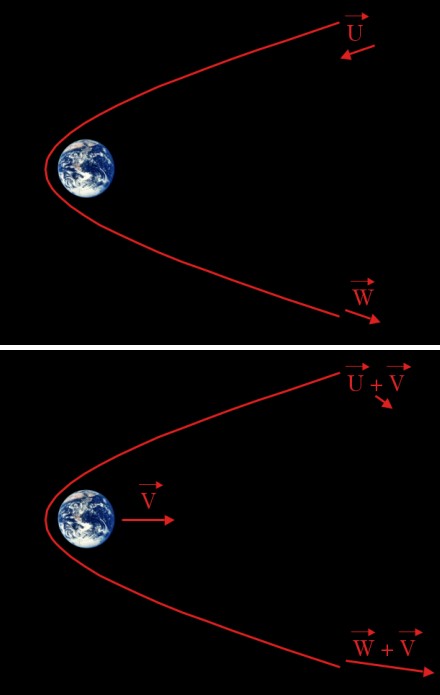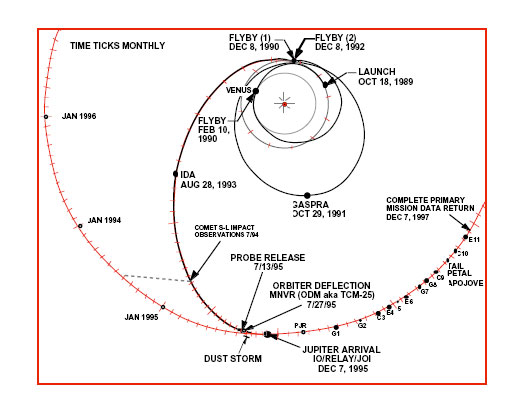Physicist: A gravitational slingshot (or “gravity assist”) is a slick way to pick up speed using a moving planet’s gravity. What’s confusing about the gravitational slingshot is that, from the point of view of the planet, the object in question comes flying in from space with some amount of kinetic energy, and leaves
with the same amount of kinetic energy (conservation of energy). So how can it speed up?
Here’s the slickness: the Galilean Equivalence Principle. The GEP states that the laws of physics work the same whether you’re moving (at a constant speed) or not. So if you look at the exact same situation from another perspective, where the planet is moving, you’ll notice that the incoming and outgoing speeds are different.

An object that passes by a stationary planet will approach and leave at the same speed (but in different directions of course). However, if the planet is moving, then the incoming and outgoing speeds are different.
Here’s voyager 1 and 2 doing their slingshot thing.
The total change in velocity, , experienced by the slungshot object is
, where
is the incoming speed (from the planet’s perspective), and
is the angle between the incoming and outgoing trajectories (again from the planet’s perspective). So in general, a sharper angle yields a bigger boost.

The course of the Galileo probe. After it's initial launch it did three slingshots, around Venus, Earth, and Earth again, to gain enough speed to get to Jupiter's orbit.
A slingshot increases the kinetic energy of the object in question by decreasing the kinetic energy of the planet. But don’t worry too much, an ant pushing a tricycle is having about one hundred quadrillion (1017) times more effect. Gravitational slingshots are used primarily for the probes we’ve sent to the outer solar system. It lowers the fuel costs a lot, but all the wandering around makes the trip quite a bit longer.







Pingback: Q: Can we build a planet? « Ask a Mathematician / Ask a Physicist
If I had a profound distaste for Mars, could I theoretically slingshot a bunch of big rocks around it until it fell into the sun? How long would this take? About how much rock material would be needed?
You could. It would require on the order of a Mars’ worth of material to do.
If you were in a hurry I suppose you could do it all at once, with a single object (if you can find one big enough).
What’s the numerical figure for a gravitational slingshot past Jupiter? Thanks.
I’m writing a story in which humans from the future have learned how to use the ‘slingshot effect’ to travel back in time. Is this theoretically possible and how can I have my characters explain it so that it makes sense without being too long-winded and technical – regardless of whether the theory holds any water? (This is fiction, after all) – any response would be gratefully received (if if it is just to say that it is all bunkum!)…
Why doesn’t the earth decelerate the object back to its incoming velocity as it heads away from the earth?
Pingback: Crowdsourcing Astronomy: DISCOVER Readers Fight Asteroid Threat - PEOPLES MEDIA 24
Or, if you like Mars on the other hand you could hurl comets at it in a trajectory that decelerates it when they get captured by his grav field at the same time dropping some oceans on him and putting him on a (slightly) smaller orbit around the sun… You’d have to find just the right comets though… i doubt this would be feasible on a terraforming time table of few centuries.
btw. very nice explanation, always wondered where the deltaV would come from.
@Elaine: If you’re talking Star Trek 4 type of slingshot, that was based on an episode in TOS, so you could look that up. However, in reality, the Sun’s mass is far too small to distort space-time sufficiently. What you need is a black hole that rotates rapidly. A pulsar (neutron star) might do too. Rotating massive objects twist space-time, and it can “pile up”. The ride would be rough as you fly around it very close to the event horizon, but there are enough unknowns and exotic things going on that you could easily contrive just about any plausible fiction you wanted.
Or you could try to rewrite the story such that the mechanism is irrelevant or unknown; many time travel stories do this.
Pingback: Q: If the Sun pulls things directly toward it, then why does everything move in circles around it? | Ask a Mathematician / Ask a Physicist
Is the decrease in kinetic energy (rotation?) of the planet perminant? Could the planets rotation be increased by an identical but reversed approach?
Why doesn’t the earth decelerate the object as it heads away from the earth?
And how is the object launched out of it’s orbit around the earth once it achieves the needed velocity ? Please reply asap
@Mihir H
The Earth does decelerate the object as it moves away, but not as much as it accelerates it overall. Objects that are slungshot are never in orbits, they’re merely passing by. If an object is in orbit, then it’s stuck there.
Pingback: Q: Why are many galaxies, our solar system, and Saturn’s rings all flat? | Ask a Mathematician / Ask a Physicist
Pingback: Q: What is the state of matter in deep space? | Ask a Mathematician / Ask a Physicist
Suppose human were to travel in a spacecraft that accelerates by gravity assist – what would the g-force on the body be?
That doesn’t make a shred of sense. The same gravitational force that helps you by being “pulled” on the backside of the planet ( so as to go along with it as well as adding your own velocity) is the same gravitational force that is suddenly going to let you go when exiting at this precise time, in the same direction the planet is now moving. Newsflash: you can’t even find missing planes that take off out of Indonesia.
What is the max velocity gained by a sling shot (say from the moon)? Maybe using a spaceship traveling at 100k mph to start?
I am at present an old man—but when I was in the navy ( WWII) in the radio lab we
had a large —very large radar magnet—-it had a keeper in it about the size of a hockey puck—–we used to take the WWII pennies and try and hit the “sweet spot” and have them “sling shot” around the magnet—–one out of ten trys would work.
on the tenth you would get hit in the head—-by this time one has dropped their guard.. I would like to build this toy—-with the two —100 pound pull magnets
that I have—would you make some suggestions please
“To reiterate: the correct theory of gravity – that we know – General Relativity – says that gravity is the curvature of spacetime due to matter and energy. In curved spacetime, masses follow geodesics – straight paths. That is – they do not accelerate. And because they do not accelerate no force is needed to change their velocity (Newton’s Second Law is still universally true, even given General Relativity. Observations falsify Newton’s Law of Gravity: but not his laws of motion (see note [1] at the end of this article). Because in 4 dimensional spacetime they are not changing their velocity. They are following the shortest path between points in curved space around a mass.”
Based on this… how is it possible that gravity can accelerate an object over and over again if its already traveling at ‘terminal velocity’ from the first slingshot maneuver and its not losing any energy traveling through space?
Pingback: There’s something new under the Sun! | Ask a Mathematician / Ask a Physicist
Pingback: Q: Is reactionless propulsion possible? | Ask a Mathematician / Ask a Physicist
Space-time theory does not disprove the law of gravity. We don’t possess the means to determine whether or not the relative time-shifting one experiences at high velocity is caused by gravity or some other, unknown phenomenon. We know that they are somehow related, but everything else is guesswork. It does, however, provide a convenient way to illustrate the law of gravity to someone who has trouble with spatial reasoning.
this makes no sense.
How can the “object” passing a “stationary” planet leave the pull of the planet that was good enough to make the object reverse direction, yet allow the object to escape that gravity? the object MUST use rocket power to escape that gravity , similar to when an object leaves the surface of the planet. But no such rocket power was needed.
Next problem, you say that the object picks up some of the planets velocity, because the planet is actually moving. How does the object KNOW this? As far as the object is concerned, according to Einstein, the Planet is stationary, or it is stationary and the plane is moving. BUT MOVING IN RELATION TO WHAT? if you say the planet is moving into relation to the sun, say at 70,000 mph, great, but the planet is also moving in the galaxy at 700,000 mph, so why not pick up the velocity from that motion?
The object is able to pick and chose which relative motion it wants to leverage? Very clever of it. Slingshot effect seems to be a physical impossibility. Individual frames of reference do not exist and cant make a scrap of difference to real physics, they are imaginary.
Pingback: Q: Asteroid mining. Why? | Ask a Mathematician / Ask a Physicist
Dear Physicist,
Why in the pictures the incoming object has arrows pointing away from the direction it is travelling in? More specifically, in the bottom picture all the arrows are pointing opposite to the direction the object is travelling in?
Could you please explain this?
Thank you!
@Atif
I should go back and clean that up.
Pay attention to the arrows under the letters, they’re the velocity vectors (speed and direction). In the top picture, where the planet is sitting still, the incoming and outgoing velocities have the same speed (same length), they just point in different directions. In the lower picture, imagine how everything would be moving if you, “the camera”, were sliding to the left. The incoming velocity would actually be pointing a little to the right (if the planet is moving fast enough) and the outgoing velocity is also pointing to the right, but much faster.
Thank you very much for your prompt and detailed explanation.
Could I take this opportunity and ask one more question?
What happens if an object enters from behind a stationary planet’s gravity (meaning with the spin of the planet anti-clockwise spin) and only climbs up to its north pole?
Will the object still manage to take a U-shaped turn?
Will the object gain speed in respect to the Sun?
Your expert opinion would really help me understand the topic. Thanks again!!
@Atif Dost
In general, if the outgoing direction points more in the direction of the planet’s movement than the incoming direction, then it’ll speed up. Coming from behind, so that you’re catching up to the planet, is a great way to lose speed, since you’re doing exactly the opposite of what’s in the diagram.
Thanks again!
My question was regarding a imaginary stationary planet that is spinning only on its axis not an orbiting planet. Cheers!
Now i dont know much and im not a scientist but even if it enters orbit with certain speed and size im sure it can burst threw the orbit back out while it travels in a curve. like a Lighting bolt that wanted to be a thunderbolt.
But it be a shorter curve and would bring some opposite force to the main gravity from play in orbit.
Too the physicist.